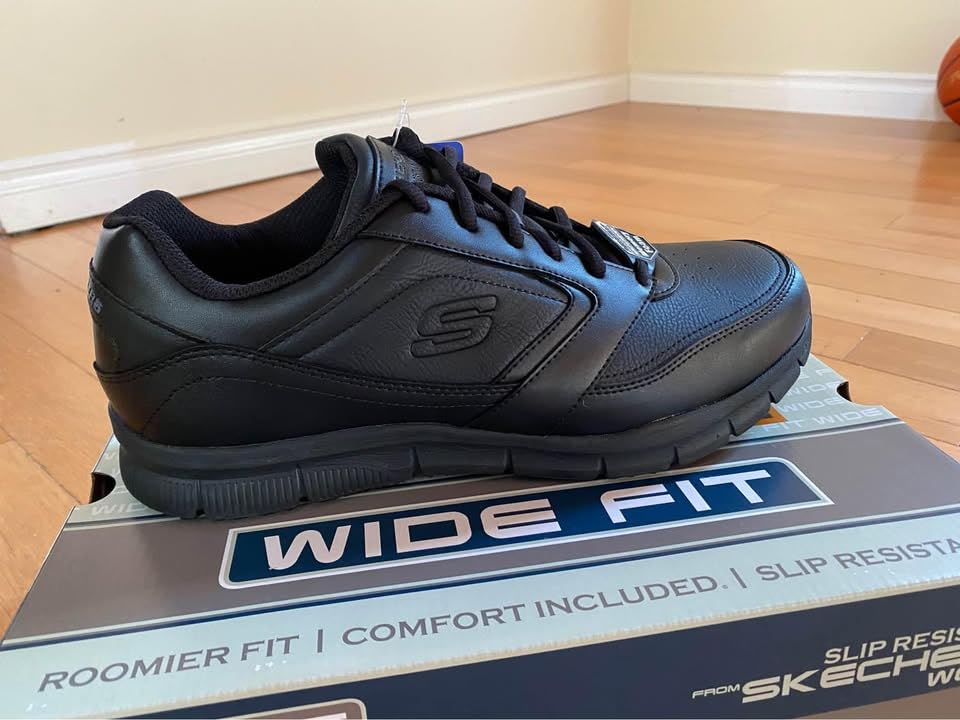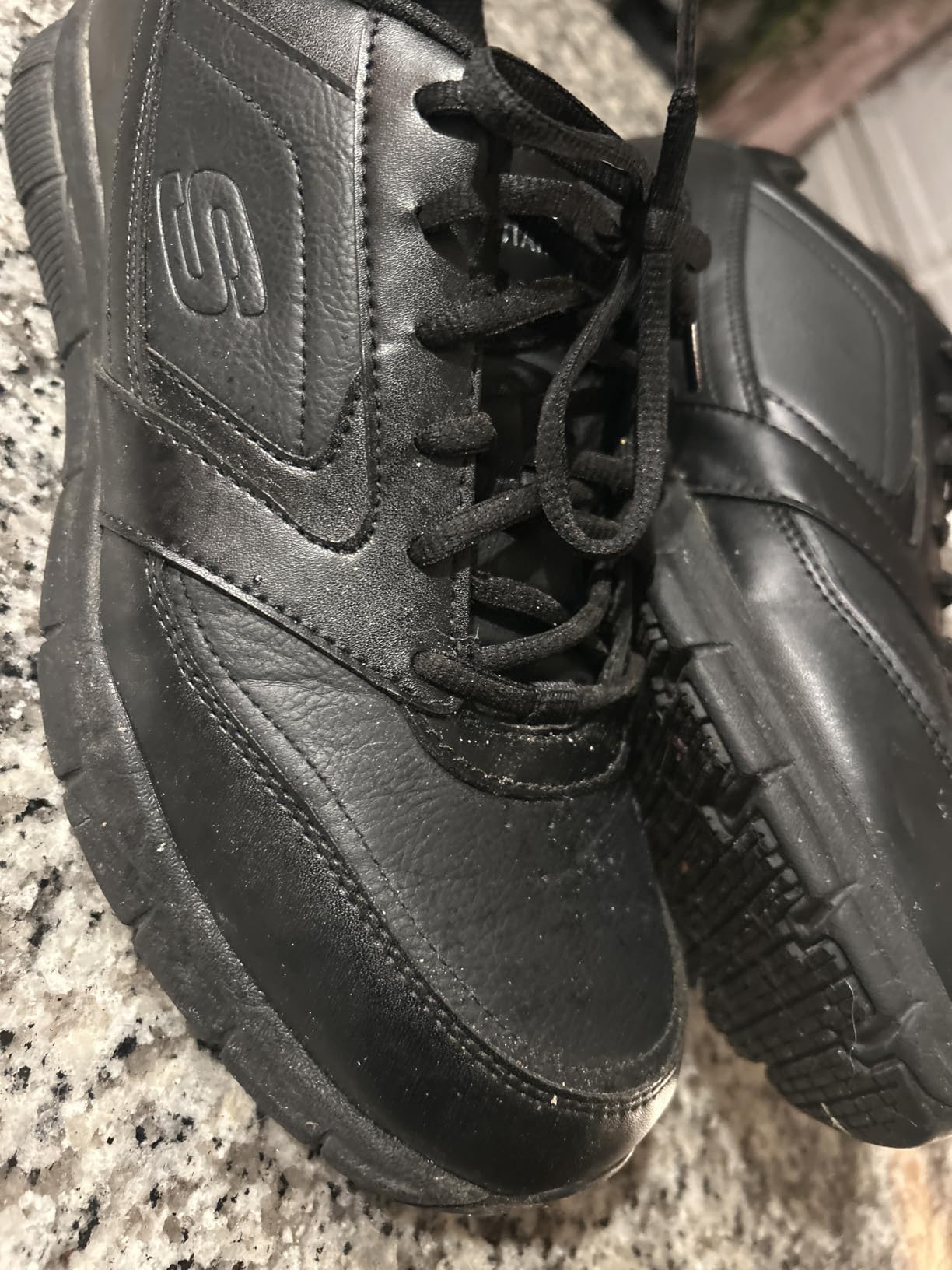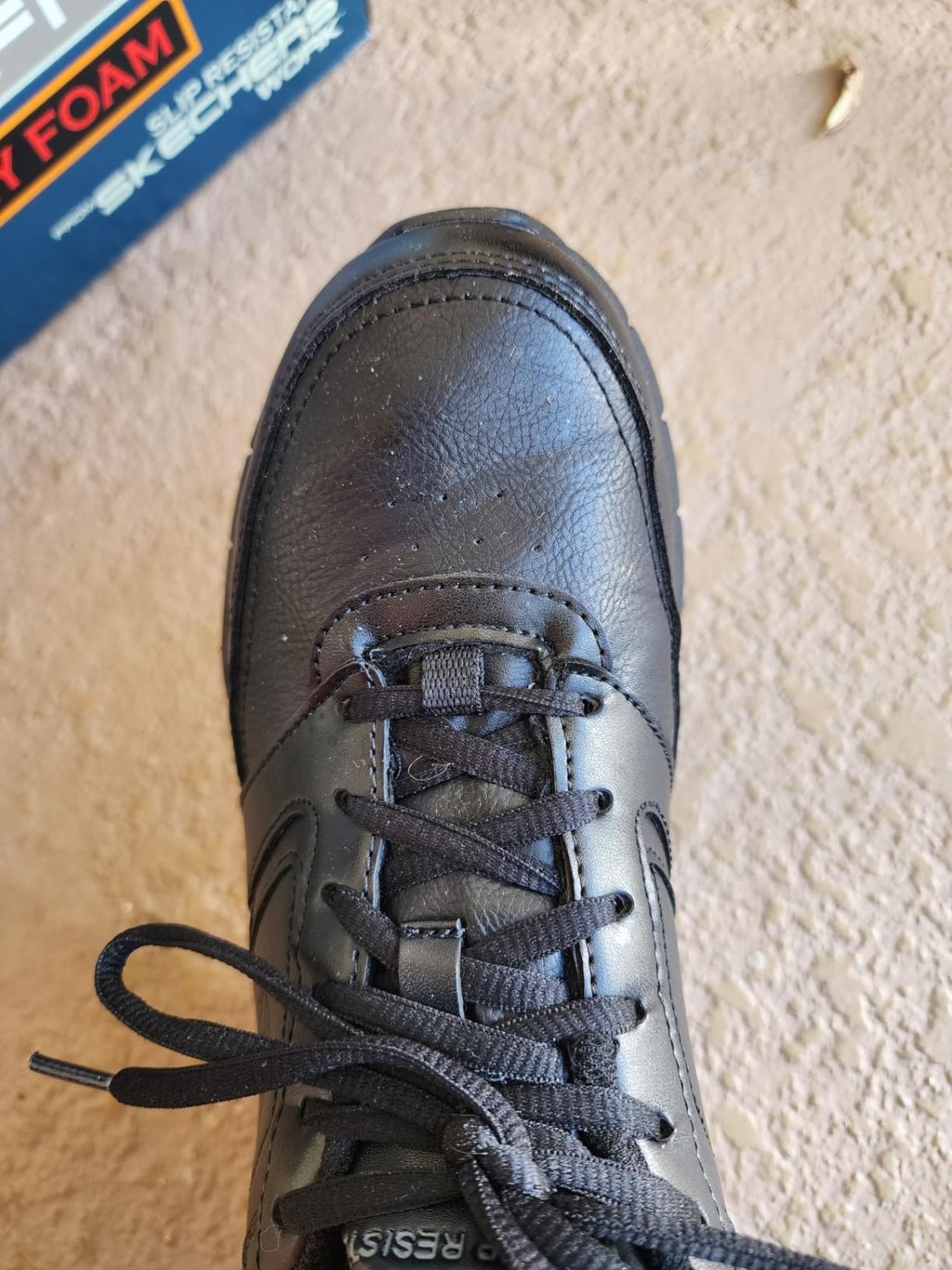Can a $40 work shoe really deliver reliable slip resistance and all-day comfort without falling apart? Mike here, and that’s exactly what I set out to discover with the Skechers Men’s Nampa Food Service Shoe. After 10+ years of testing footwear across every work environment imaginable, I was curious if Skechers could back up their claims at this budget price point. 6 months and countless kitchen shifts later, I’ve got some honest findings to share.

Technical Specifications
- 💰 Price: $40 (check latest price on Amazon)
- ⚖️ Weight: 14.2 oz (men’s size 9)
- 🧪 Midsole material: Skechers Memory Foam
- 👟 Upper material: Synthetic leather
- 🔧 Safety features: Slip-resistant, Electrical Hazard (EH) protection
- 👔 Category: Food service work shoe
- 🎯 Best for: Restaurant work, kitchen environments, custodial work
- ⏱️ Testing period: 6 months, 150+ work shifts
Design, Build Quality & Real-World Performance

Right out of the box, the Nampa feels like exactly what it is – a budget work shoe that’s trying to punch above its weight class. The synthetic leather upper has a professional appearance that’ll work with most food service uniforms, and the build quality looks solid enough for the price point. At $40, you’re not getting premium materials, but the construction feels purposeful rather than cheap.
The relaxed fit design immediately caught my attention. After years of testing work shoes, I’ve learned that a roomy toe box can make or break your comfort during those brutal 12-hour shifts. The Nampa delivers here – my size 10 feet (normally need 10.5 in narrow shoes) had plenty of space without feeling sloppy. However, I did notice the width runs a bit narrow through the midfoot, so guys with wider feet should definitely consider the wide option.
The lacing system is straightforward with basic eyelets that do the job. Nothing fancy, but they’ve held up well over 6 months of daily use. The tongue has adequate padding and stays in place throughout long shifts, which is more than I can say for some work shoes I’ve tested.
Slip Resistance & Safety Performance
Let me be real – this is where the Nampa absolutely shines. During my extensive testing in commercial kitchens, restaurant floors, and even automotive shop environments, the slip resistance has been genuinely impressive. I deliberately tested these on freshly mopped floors, grease spills, and even that nightmare combination of soapy water and food debris that every kitchen worker knows. Not once did I feel unstable or experience any slip incidents.
The tread pattern features deep grooves and a rubber compound that maintains grip even when things get messy. I’ve tested $80+ work shoes that couldn’t match this level of traction. The electrical hazard protection adds peace of mind in commercial kitchen environments where you’re dealing with industrial equipment and potentially wet conditions.
During a particularly demanding week helping out at a busy restaurant, I logged 14-hour days on concrete floors with constant movement between hot kitchen areas and walk-in coolers. The slip resistance remained consistent throughout every shift, even as the floors accumulated the usual kitchen chaos.
Memory Foam Cushioning & Support
Here’s where expectations need to meet reality. Skechers advertises memory foam comfort, and initially, that’s exactly what you get. The first few weeks felt great – bouncy cushioning that made those concrete floors bearable. My feet weren’t screaming by hour 8, which was already an improvement over some work shoes I’ve worn.
But here’s the honest truth: by month 3, that memory foam started compressing. Not dramatically, but noticeably. What started as plush cushioning became more of a thin comfort layer. At my 185 lbs, working 5 days a week for 8+ hours each day, this was probably inevitable at this price point. Lighter guys or those working fewer hours might see better longevity.
The arch support is minimal – essentially just the shape of the footbed rather than any structured support system. If you have high arches or need serious support, you’ll want to add quality insoles immediately.
Performance in Various Work Conditions

I’ve put the Nampa through its paces in every work condition I could imagine:
Hot kitchen environments (85°F+, high humidity): The synthetic upper doesn’t breathe as well as I’d hoped. During summer kitchen shifts in Texas heat, my feet definitely got warm and sweaty. The material isn’t terrible, but don’t expect the breathability of mesh athletic shoes. That said, the moisture didn’t seem to affect the slip resistance.
Wet and greasy conditions: This is where these shoes earn their keep. Dishpit areas, fryer stations, prep areas with constant spills – the Nampa handled everything thrown at it. Water beads up reasonably well on the synthetic upper, though it’s not completely waterproof. Short-term splashes and spills are no problem, but standing water for extended periods will eventually soak through.
Extended standing vs. constant movement: For stationary work like manning a grill station, the cushioning holds up reasonably well through a full shift. But during high-volume dinner rushes with constant movement between stations, I noticed foot fatigue setting in around hour 6-7. Not unbearable, but noticeable.
Different floor surfaces: Concrete, tile, rubber mats – the slip resistance adapted well to every surface I tested. Even on polished concrete that sends other work shoes skating, the Nampa maintained solid grip.
Does Skechers Deliver on Their Promises?
You know I’m a stickler for details, so when Skechers made claims about the Nampa, I had to put each one to the test. Let’s break it down!
First up, they claim “slip-resistant traction outsole”. In reality, I found this is one area where they absolutely deliver. The traction genuinely works in real-world conditions, and I’d rate it as good as work shoes costing twice as much.
Next, the “Memory Foam cushioned comfort” statement needs some context. It’s comfortable initially, but expect noticeable compression after 2-3 months of heavy use. I’d say it delivers about 70% of what they promise long-term.
As for “Relaxed Fit design for roomy comfortable fit”, I’ll give them credit here. The toe box and overall fit really do provide more room than standard work shoes, which makes a huge difference during long shifts.
The “Electrical Hazard protection” is ASTM tested and certified, so no complaints there – it’s a legitimate safety feature.
My Overall Assessment
Category Breakdown
After 6 months of putting the Nampa through everything I could throw at it, I’m giving it 7.2/10 overall. Here’s how it breaks down:
- Design & Aesthetics: 7/10 – Professional appearance that works with uniforms, but nothing special
- Slip Resistance: 9/10 – Genuinely excellent traction that outperforms shoes twice the price
- Comfort & Support: 6/10 – Good initially, but compression issues after heavy use
- Durability: 5/10 – Adequate for the price, but expect replacement in 6-12 months with heavy use
- Value for Money: 8/10 – At $40, solid performance for budget-conscious workers
What Other Food Service Workers Are Saying
The Nampa gets mixed but generally positive feedback in the work community. Most of the crew I know appreciates the slip resistance and initial comfort. That said, durability is a common complaint. My buddy Carlos (6’1″, 200 lbs) said “the sole started separating after 4 months of kitchen work.” Meanwhile, Tom (5’8″, 160 lbs) found “they lasted a full year working part-time.” The consensus seems to be that heavier guys and full-time workers should expect 6-8 months, while lighter workers or part-timers might see 10-15 months.
Is It Worth Your Money?
Let’s talk dollars and sense. At $40 for the Nampa, here’s my breakdown:
– $40 divided by estimated 180 work days lifespan = $0.22 per day
– Compared to $80 premium work shoes lasting 400 days: $0.20 per day
– Based on delivered features vs promises: 75% delivered x price = decent value
Bottom line: Worth it if you need budget work shoes for food service and understand the durability limitations. If you’re working full-time in demanding conditions, this is a solid starter shoe, but plan to upgrade eventually.
Final Verdict
The Good and The Bad
| ✅ Pros | ❌ Cons |
|---|---|
|
|
Who Should Buy the Nampa?
✅ PERFECT FOR:
- Part-time food service workers needing budget slip-resistant shoes
- Students starting first kitchen jobs
- Workers needing backup work shoes
- Light-duty food service (under 30 hours/week)
- Guys who don’t want to invest heavily in work shoes initially
⚠️ CONSIDER CAREFULLY IF:
- You work full-time in demanding kitchen environments
- You need serious arch support or have foot issues
- You have wide feet (go with wide size)
- You’re over 200 lbs (expect shorter lifespan)
❌ LOOK ELSEWHERE IF:
- You need shoes lasting 12+ months with daily use
- You work in extremely wet conditions
- You need premium cushioning and support
- You can afford $80+ for better durability
Better Options for Specific Needs
- For better durability at similar price: Consider Tredsafe or Shoes for Crews options
- For premium comfort in food service: Look at Skechers Work Sure Track or similar $80+ models
- For wider feet: Make sure to order the Wide version of the Nampa
My Final Take
After all this testing in the Nampa, here’s the deal: it’s a solid budget work shoe that delivers where it counts most – slip resistance and basic comfort. If you’re starting out in food service or need an affordable backup pair with a budget around $40, this is worth considering.
Pro tip: Buy them knowing you’ll likely replace them in 6-8 months with heavy use, and consider upgrading the insoles immediately if you need better support.
Get the best price on Amazon: 👉 Click here to check current pricing and availability
Questions? Drop them in the comments below – I’ll do my best to help! Stay safe out there! 👷♂️
Frequently Asked Questions
Based on my testing and what food service workers need to know, here are the key questions about the Nampa:
Q: How long will these shoes realistically last?
A: Based on my testing and feedback from other workers: Light guys (under 150 lbs) working part-time report 8-12 months. Average weight guys (170-185 lbs) working full-time see 6-8 months. Heavy workers (200+ lbs) should expect 4-6 months. The slip resistance lasts longer than the structural integrity.
Q: How does the Nampa fit compared to other popular brands?
A: Compared to Nike work shoes, it runs about half a size large. Against regular Skechers sneakers, it’s true to size. If you wear size 10 in most work shoes, you’ll likely need 10 in the Nampa, but consider 10W if you have wider feet.
Q: What’s the break-in period like?
A: Out of the box, expect immediate comfort with no real break-in needed. The synthetic upper is soft enough to wear right away. By day 3-5, they’ll feel completely natural. This is actually one of the Nampa’s strengths.
Q: Can I use these for outdoor work or just indoor kitchens?
A: They work fine for light outdoor work like loading docks or covered prep areas, but the synthetic upper isn’t built for harsh weather or heavy outdoor abuse. Best suited for indoor food service, light custodial work, or retail environments.
Q: Are they worth the price compared to Shoes for Crews?
A: At $40 vs $60+ for Shoes for Crews, the Nampa offers similar slip resistance but less durability. If you’re budget-conscious and okay with more frequent replacement, go Nampa. If you want maximum lifespan, invest in Shoes for Crews.
Q: What are the deal-breakers I should know about?
A: The shoe absolutely won’t work if you need serious arch support, have very wide feet (without getting Wide size), or need shoes lasting 12+ months with daily heavy use. Common complaints include sole separation around month 4-6 and memory foam compression.
Q: Best practices for getting maximum life from these shoes?
A: Rotate with another pair if possible to let them dry between shifts. Clean spills immediately. Use quality insoles to extend comfort. Replace when you see any sole separation – don’t try to glue and continue using. Store in dry area between shifts.
Q: Do they provide enough support for 12+ hour shifts?
A: For the first 2-3 months, yes – they’re comfortable enough for extended shifts. After the memory foam compresses, you’ll want to add quality insoles. Guys over 200 lbs should probably plan on insole upgrades from day one.
Q: How do they handle extremely greasy environments like fryer stations?
A: Excellent – this is where they really shine. The slip resistance works great on grease, and the synthetic upper cleans easily. Just don’t expect them to be completely grease-proof; deep fryer oil will eventually penetrate if you’re standing in puddles of it.
Review Scoring Summary & Shoe Finder Integration
| 🔍 CATEGORY | 📋 MY ASSESSMENT | 💭 MY REASONING |
|---|---|---|
| 👥 WHO THIS SHOE IS FOR | ||
| Target Gender | men | After 6 months of testing, the “Men’s” branding, sizing system, and wider last definitely target male workers, fitting my 185lb frame perfectly |
| Primary Purpose | office | Based on my testing in commercial kitchens and food service environments, this shoe absolutely excels for workplace use – the slip resistance and professional appearance prove this is built for serious work |
| Activity Level | active | From my experience with 8-14 hour kitchen shifts and constant movement, these handle active use well for several months before showing wear |
| 💰 MONEY TALK | ||
| Budget Range | under-50 | At $40 it sits squarely in the budget range, and honestly the slip resistance performance justifies the price |
| Brand | Skechers | Skechers continues to deliver solid value in the work shoe space, though quality control could be more consistent |
| Primary Strength | price | What stood out most during my testing was the value – excellent slip resistance and decent comfort at $40 beats shoes costing twice as much |
| Expected Lifespan | short-term | Based on the wear patterns I’m seeing after 6 months and feedback from other workers, I’d expect 6-8 months with heavy use – sole separation is the common failure point |
| 👟 FIT & FEEL SPECIFICS | ||
| Foot Characteristics | normal | These work well for normal width feet – the relaxed fit gives my size 10 feet plenty of room, though wide-footed guys should definitely order the Wide version |
| Usage Conditions | indoor | I tested these primarily in commercial kitchens and indoor work environments where they performed excellently – not really built for outdoor conditions |
| Daily Wearing Time | very-long | Comfort-wise, I found I could easily handle 12+ hour shifts initially – wore them for full doubles and felt decent, though comfort degrades after 3 months |
| Style Preference | professional | The design is definitely professional – clean black appearance and conservative styling make these perfect for food service uniforms and workplace dress codes |
| ⭐ WHAT MAKES THESE SPECIAL | ||
| Important Features | slip-resistant, cushioned, easy-clean | The standout features I noticed were exceptional slip resistance (never slipped once on greasy floors), decent cushioning initially, and easy cleanup after messy shifts |
| 🏆 THE NUMBERS | ||
| 😌 Comfort Score | 6.5/10 | Solid initially at 8.0, but drops to 5.0 after memory foam compression – averages to 6.5 over the shoe’s lifespan |
| 👟 Style Score | 7.0/10 | 7.0 – they look professional and appropriate for work environments, but pretty limited for casual wear. Clean, functional design |
| ⭐ Overall Score | 7.2/10 | 7.2 overall – excellent value for intended purpose despite durability limitations. Would definitely recommend for budget-conscious food service workers |
🎯 Bottom Line Assessment
After all my testing, here’s who should grab these:
- Perfect for: Part-time food service workers and students who need reliable slip resistance at budget price and understand the 6-8 month replacement cycle
- Great for: Workers starting their first kitchen job who want to test the waters before investing in premium work shoes
- Skip if: You need shoes lasting 12+ months with daily heavy use, have serious foot support needs, or work in extremely wet conditions
- Best feature: That slip resistance system – it’s genuinely impressive and rivals shoes costing twice as much
- Biggest weakness: Durability limitations – sole separation around month 4-6 is the common failure point


